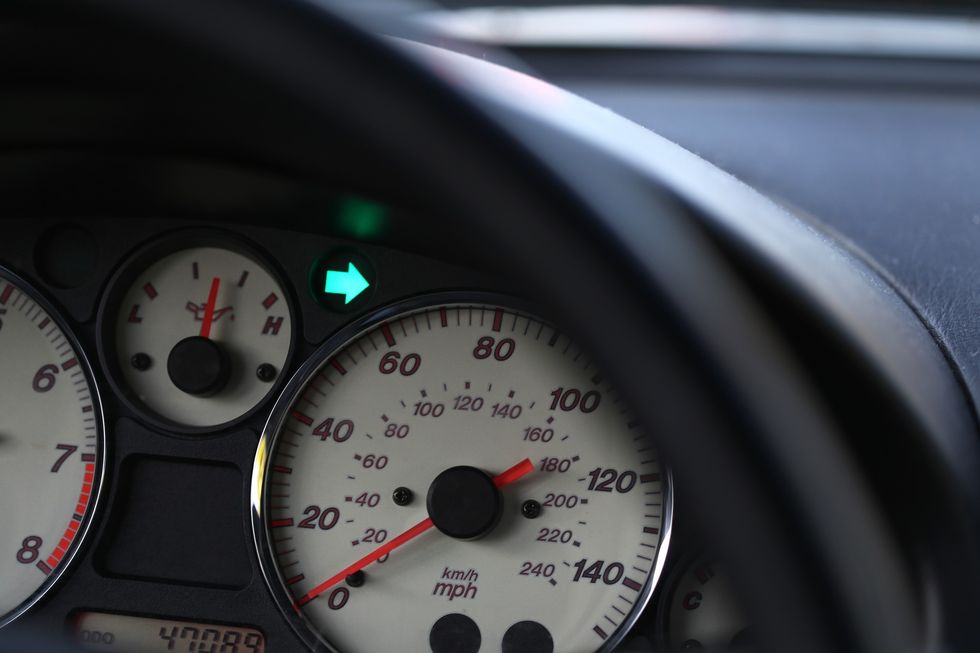Drivers warned of common driving defect carrying £2,500 fine and breaks Highway Code rules

Indicators should blink between 60 and 120 times per minute
Don't Miss
Most Read
Latest
Experts are warning drivers of a common car fault which could see motorists slapped with hefty fines and break the Highway Code if ignored.
A rapidly flashing indicator light on a vehicle could be a warning of a serious electrical fault which, if left unattended, could cause greater damage.
Now motorists are being urged to make sure they get their indicator light fixed as soon as possible as it could breach Rule 103 of the Highway Code.
The rule looks to ensure that signals to other road users and pedestrians are clear at all times which can help prevent injury while travelling.
Do you have a story you'd like to share? Get in touch by emailing motoring@gbnews.uk

The signalling light should not blink too fast
|GETTY
The rule dictates: “Give clear signals in plenty of time, having checked it is not misleading to signal at that time. Use them to advise other road users before changing course or direction, stopping or moving off. Cancel them after use and make sure your signals will not confuse others.
“If, for instance, you want to stop after a side road, do not signal until you are passing the road. If you signal earlier, it may give the impression that you intend to turn into the road. Your brake lights will warn traffic behind you that you are slowing down. Remember that signalling does not give you priority.”
Experts have stated that indicators should blink between 60 and 120 times per minute, according to official Government guidance.
A light that blinks faster than this signposts an underlying issue, Graham Conway, managing director at Select Car Leasing, warned.
He said: “The most common cause is that one of the indicator bulbs on the side of the car in which you’re turning has blown. It might be the front bulb, the bulb on the side of the car near the door, the bulb in your wing mirror, or the indicator light at the rear.
“If an indicator bulb isn’t illuminating, that’s clearly bad news as it means that you’re not capable of signalling your intentions to other road users.
“If you’re pulled over by the police and found to have a malfunctioning indicator, you could be issued a fixed penalty notice of £50.”
The police may also issue drivers with a vehicle defect rectification notice which means that they will have 14 days to fix the problem and provide proof to the police.
If indicators are going at double the speed they normally would, Conway said it might also indicate a more serious fault with the electrical wiring in the car.
It could be a faulty ground connection, a voltage supply issue, or even the wrong type of indicator bulb having been fitted, he suggested.
In a worst-case scenario, driving a vehicle with faulty indicators could be seen as driving in ‘unroadworthy condition’, which carries a fine of up to £2,500 and attracts points on a driver’s licence.
Conway commented: “If the indicator is flashing more rapidly than usual, you should be able to see and hear this difference from inside your car. To check, simply take turns indicating right and left while you’re parked and check each side of the car to find out which lamp bulb is malfunctioning."
LATEST DEVELOPMENTS:
- Martin Lewis urges drivers to 'avoid' car insurance payment method which could hike prices by hundreds
- Older motorists could see new driving laws launched amid headlight glare research - 'Huge step forward!'
- The worst motorway in England is plagued with ‘terrible’ delays, roadworks and 50mph limits - full list

Faste indicator lights can reveal an electrical fault with the vehicle
| GETTYUnder UK law, drivers are responsible for making sure vehicles are always safe to drive (‘roadworthy’). It can be unsafe even if there is a current MOT certificate.
Failure to do so can result in a fine of p to £2,500 or being banned from driving and three penalty points for driving a vehicle in a dangerous condition.










